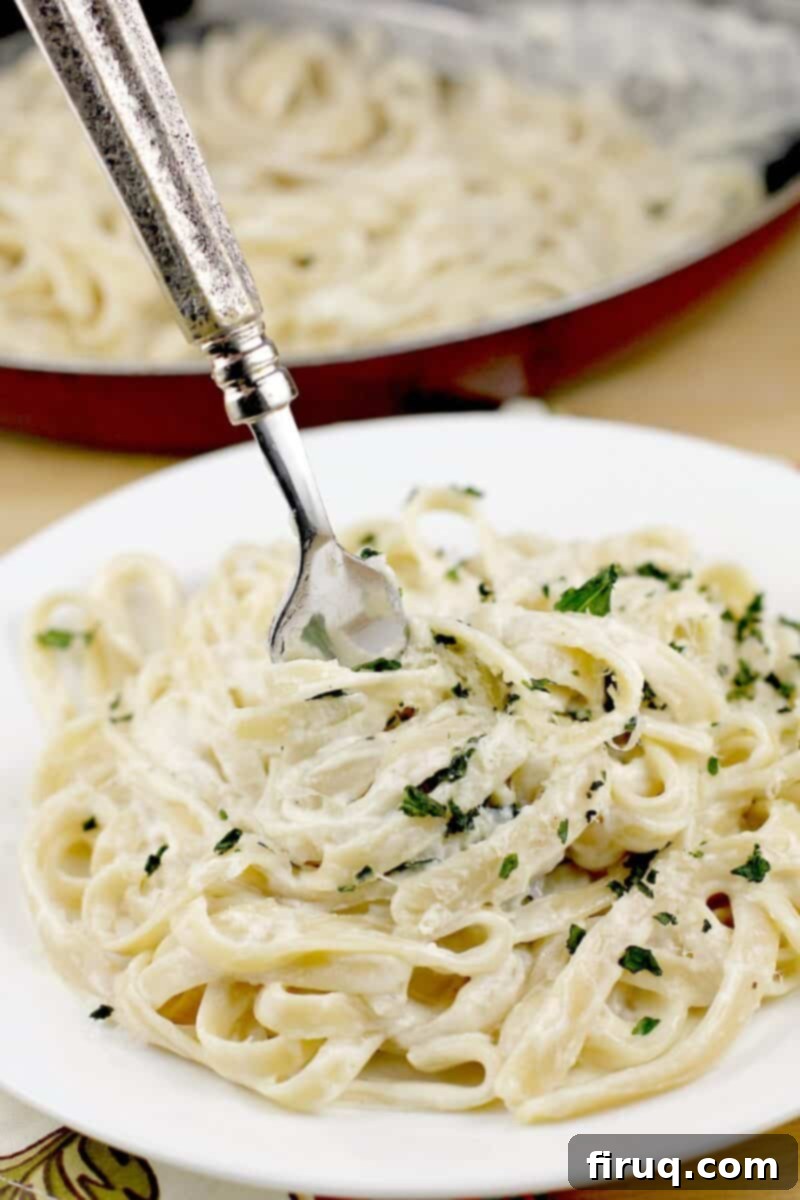The Ultimate Guide to Authentic Homemade Fettuccine Alfredo: A Creamy & Easy Recipe
Fettuccine Alfredo stands as a testament to simple culinary perfection: tender pasta enveloped in a rich, velvety cream sauce infused with aromatic garlic and exquisite fresh Parmesan cheese. This iconic Italian-American favorite is surprisingly simple to recreate in your own kitchen using just a handful of quality ingredients. This comprehensive guide provides you with detailed instructions, helpful photographs, and in-depth descriptions of each ingredient, ensuring you can master the art of making the best Fettuccine Alfredo you’ve ever tasted.
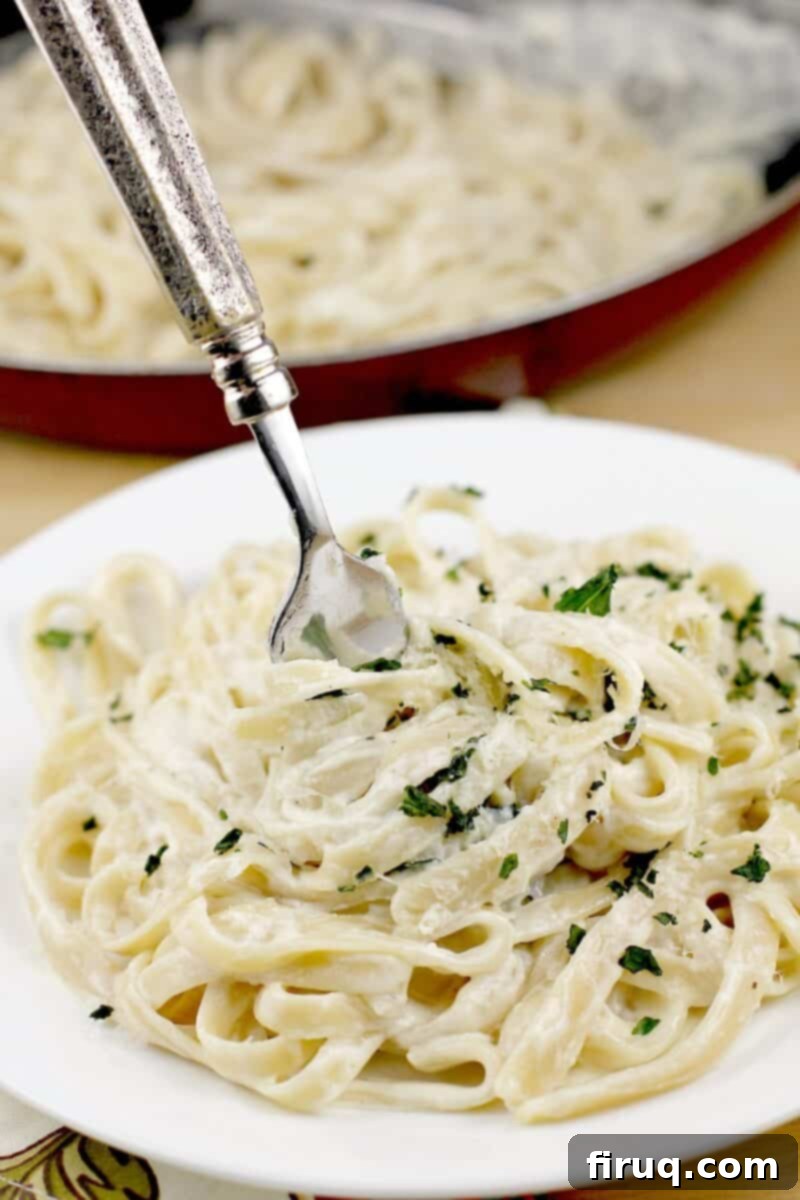
What is Fettuccine Alfredo? A Journey from Rome to Your Dinner Table
At its heart, homemade Fettuccine Alfredo is celebrated as one of the most effortlessly delicious and universally beloved pasta dishes. Its enduring popularity stems from its luxurious texture and comforting flavor, making it a timeless classic.
The origins of this famous dish trace back to Alfredo di Lelio, an Italian restaurateur who first served it in his Rome establishment during the early to mid-20th century. The original Roman version, known as pasta al burro e parmigiano, was a deceptively simple concoction of fresh pasta, butter, and young Parmigiano-Reggiano cheese, relying on the skilled emulsification of these ingredients to create a creamy sauce without the addition of actual cream. American travelers, captivated by its exquisite taste, brought the recipe to the United States in the early 1900s, where it began its transformation.
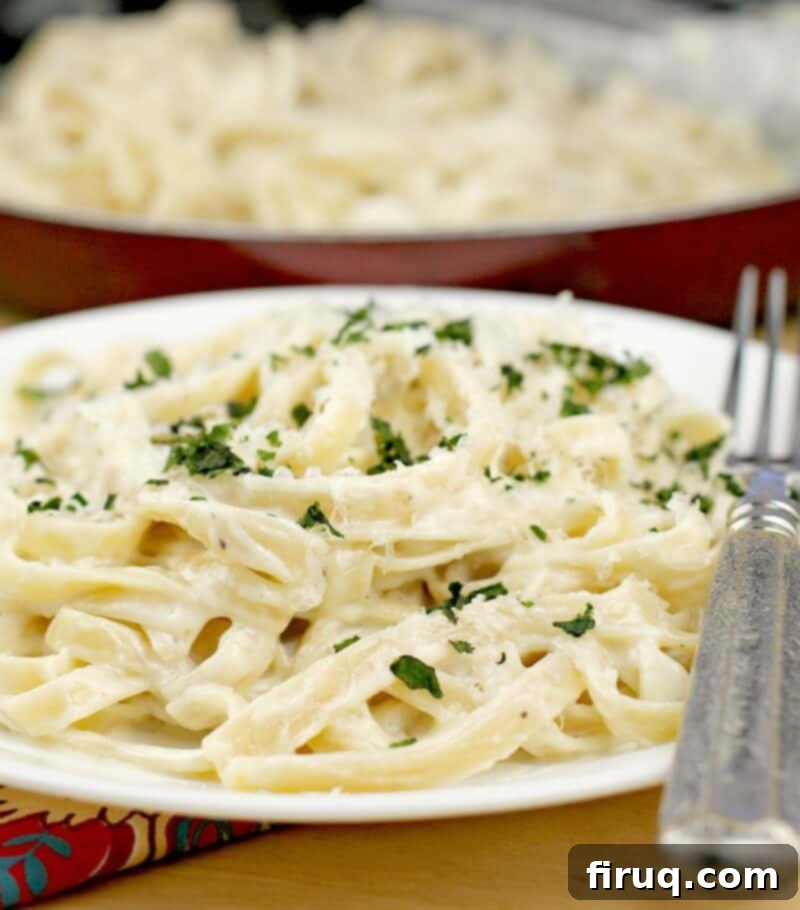
A pivotal moment in the dish’s American evolution occurred in 1966 when the Pennsylvania Dutch Noodle Company featured an Alfredo sauce recipe on their dried fettuccine noodle boxes. This recipe notably included heavy cream, thereby cementing the “Americanized” version of pasta Alfredo into popular culture. This adaptation, born out of convenience and evolving tastes, provided a more robust and consistently creamy sauce that resonated with American consumers.
The influence of restaurant chains further propelled its fame. Olive Garden, a popular Italian-American eatery, adopted the creamy Alfredo concept and added elements like garlic and often protein such as chicken or shrimp. The inclusion of meat transformed Alfredo from a light pasta course into a substantial main dish, a distinctly American innovation diverging from traditional Italian culinary customs. This rich, creamy, and often protein-enhanced version became the standard for Fettuccine Alfredo across the United States, and its immense popularity has ensured its place in countless households and restaurants to this day.
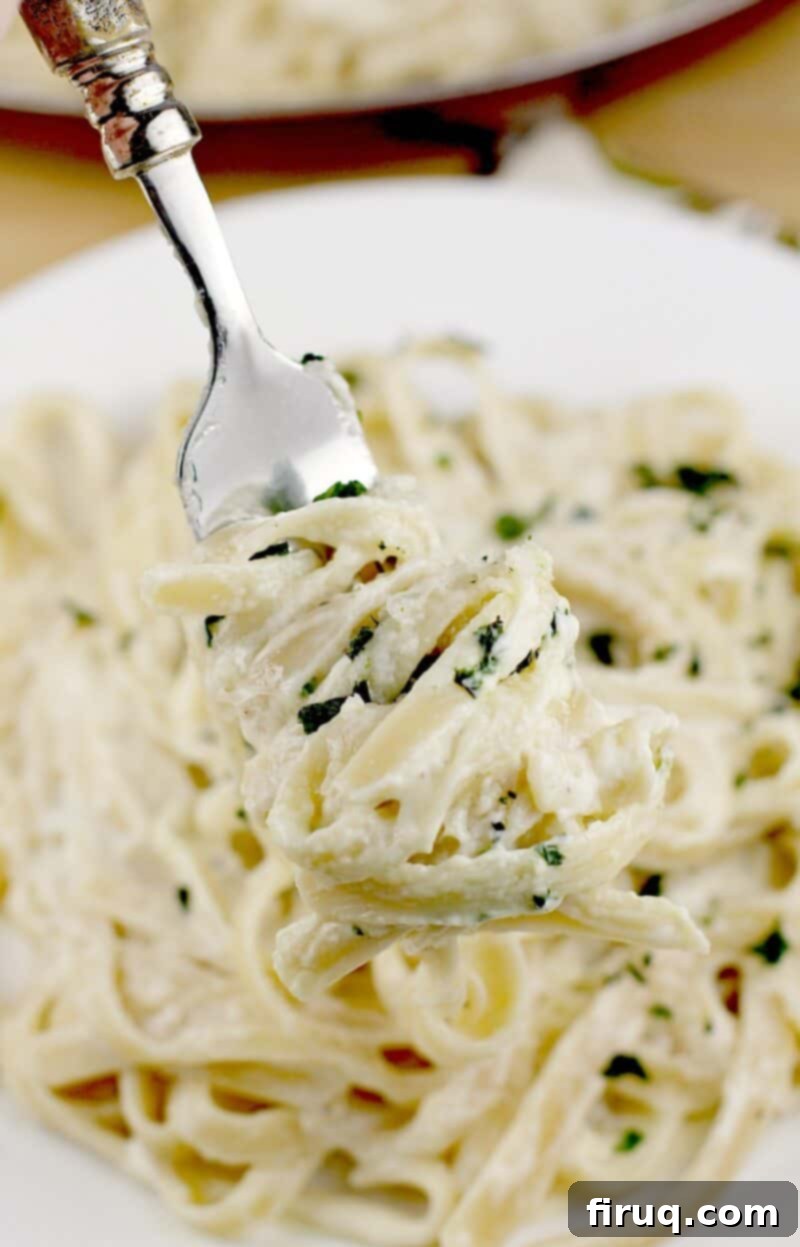
Cream or No Cream: Decoding the Alfredo Tradition
The debate over whether to include cream in Fettuccine Alfredo is a passionate one, reflecting the distinct culinary philosophies of Italy and America. Traditionally, in its birthplace of Italy, the dish known as pasta al burro e parmigiano (pasta with butter and Parmesan) is prepared with only three core ingredients: fresh pasta, high-quality unsalted butter, and young Parmigiano-Reggiano cheese. The magic of this classic lies in the precise technique of emulsification, where the starch from the pasta water, the fat from the butter, and the grated cheese are vigorously combined to form a naturally rich, glossy, and impossibly creamy sauce. This method highlights the inherent flavors and textures of each component, creating a truly exquisite experience without any added cream.
However, the American interpretation, popularized by establishments like Olive Garden and countless home cooks, almost invariably includes heavy cream, along with a touch of garlic. Is this deviation from the Italian original “wrong”? Not at all. It’s simply a different tradition, one that has evolved to suit the American palate and culinary practices. This creamy, garlic-infused version has become a beloved comfort food, and for many, it defines what Fettuccine Alfredo should be. If this “wrong” dish brings so much joy, then perhaps being right isn’t what matters most.
This culinary adaptation is a common phenomenon with many dishes that gain popularity in the U.S. Just like pizza, lasagna, and many other Italian specialties, American cooks and restaurants often put their unique spin on them. These variations become new traditions in their own right, reflecting local ingredient availability, flavor preferences, and cooking styles. Our creamy, garlic-rich Fettuccine Alfredo is a perfect example of this cultural culinary fusion, creating a distinct and cherished dish.
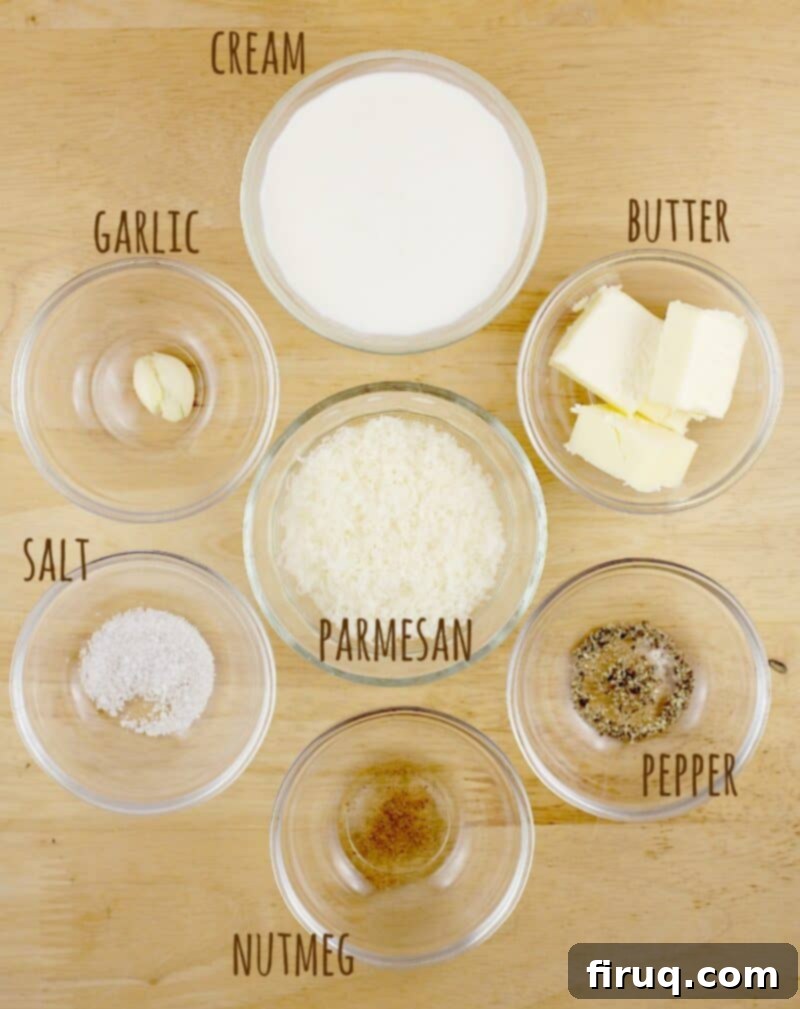
Essential Ingredients for Your Creamy Alfredo
To achieve that unparalleled creamy, garlicky, and cheesy goodness, selecting high-quality ingredients is paramount. Here’s a breakdown of what you’ll need and why each component is crucial for our American-style Fettuccine Alfredo:
- Heavy Cream: This is the cornerstone of our American Alfredo sauce. Heavy cream is essential because its high-fat content (typically 36% or more) provides the richness, body, and stability needed for a truly luscious sauce. Lighter alternatives like milk or half-and-half contain less fat and will not thicken or achieve the same velvety texture, potentially leading to a thin, watery sauce that separates easily. Stick with heavy cream for the best results.
- Unsalted Butter: Using unsalted, sweet cream butter is critical for superior flavor control. Salted butter can introduce too much sodium and often contains more water, which can affect the sauce’s texture. Unsalted butter allows you to precisely season the dish to your taste, letting the pure, creamy butter flavor shine through as a foundation for the sauce.
- Fresh Parmesan Cheese: The quality of your cheese makes an enormous difference. Always opt for fresh Parmesan, ideally a block of Parmigiano-Reggiano that you grate yourself. Pre-grated cheeses, especially those in cans, often contain anti-caking agents like cellulose which prevent smooth melting, resulting in a grainy texture and an inferior flavor profile. Freshly grated Parmesan melts beautifully and imparts a nutty, salty, umami depth that is irreplaceable.
- Garlic: Garlic provides a wonderful aromatic counterpoint to the richness of the cream and cheese. However, moderation is key. Go easy on the garlic; too much can easily overpower the delicate flavors of the sauce. Use fresh garlic, finely minced or grated, for the most vibrant taste. Avoid jarred chopped garlic, which often has a muted flavor and can sometimes carry a slightly acrid taste.
- Nutmeg: Just a small pinch of freshly grated nutmeg is the secret ingredient that elevates Alfredo from delicious to divine. It adds a subtle, warm, and earthy note in the background, enhancing the creaminess and complexity without being overtly noticeable as “nutmeg.” It’s a classic Italian touch that provides that elusive “something special.”
- Kosher Salt: Proper seasoning is vital. Kosher salt is preferred for its coarse texture and pure flavor, allowing for even distribution and careful adjustment. Remember that salt is needed not only to season the sauce itself but also to bring out the flavors of the pasta once it’s incorporated. Taste and adjust as you go.
- Fresh Cracked Pepper: A pinch of freshly cracked black pepper adds a subtle kick and aromatic warmth. While black pepper is traditional, you can substitute white pepper if you prefer a less visible spice or a slightly different flavor profile.
- Fettuccine Pasta: While our recipe calls for dried fettuccine, you can certainly use other substantial pasta shapes like linguine or spaghetti. The broad, flat surface of fettuccine is ideal for clinging to the thick, creamy Alfredo sauce. Avoid very thin pastas like angel hair, which can become overwhelmed and clump together in such a rich sauce. Cooking the pasta to a perfect al dente is crucial, as it will continue to cook slightly when tossed with the hot sauce.
- Pasta Water: This often-overlooked ingredient is an absolute game-changer. The starchy water left over from cooking the pasta is a natural emulsifier. Adding a small amount to the sauce helps it achieve that silky, cohesive texture, ensuring that the sauce beautifully coats every strand of pasta. It also helps to “extend” the sauce, ensuring there’s enough to generously coat all the noodles without making it watery.
A quick but critical note: I cannot stress enough the importance of reserving pasta water. It’s so easy to absentmindedly dump all the water down the drain after cooking the pasta. So, before you pour your cooked pasta into the colander, take a moment to scoop out at least half a cup of that starchy, golden liquid. This simple step is fundamental to achieving the perfect Alfredo consistency.
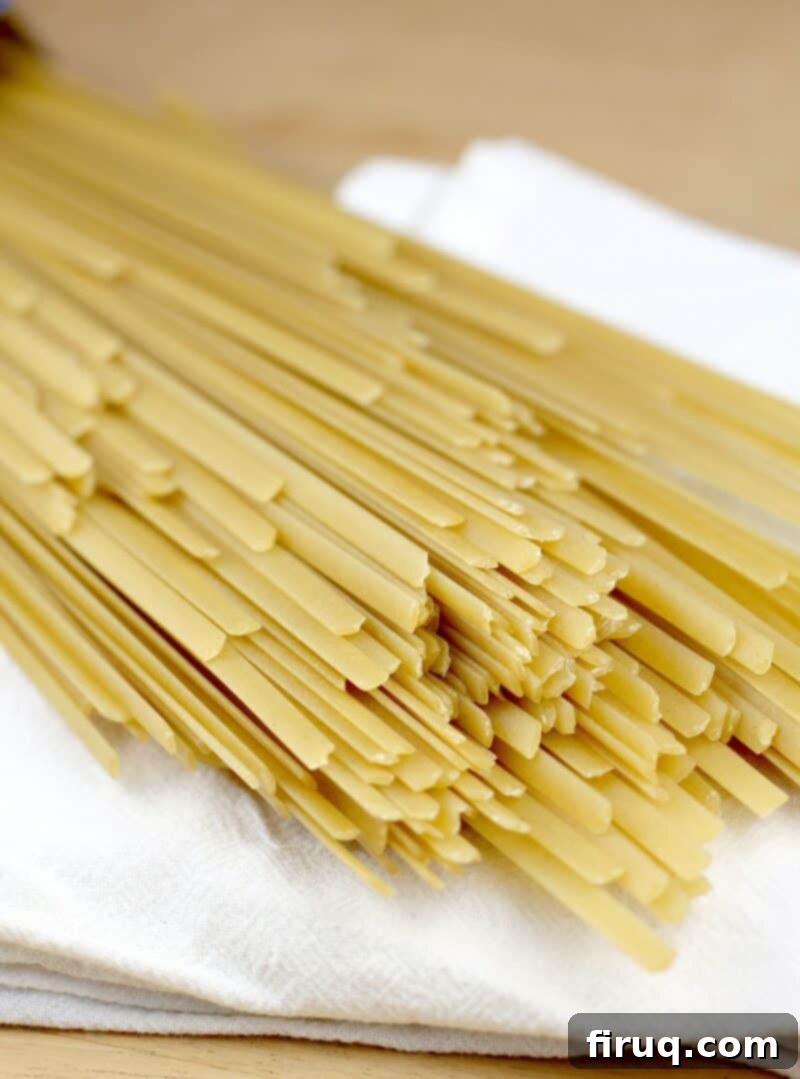
The Essential Role of Parmigiano-Reggiano Cheese
In the realm of Fettuccine Alfredo, cheese isn’t just an ingredient; it’s a star. The right cheese is paramount to achieving the authentic flavor and silky texture that defines a truly great Alfredo sauce. For this recipe, I unequivocally recommend using high-quality Parmigiano-Reggiano.
While some Alfredo recipes might suggest other hard cheeses like Pecorino Romano, I strongly advise against it for this dish. Pecorino Romano is a sheep’s milk cheese, known for its significantly more pungent, intense, and salty flavor compared to the milder, nuttier notes of Parmigiano-Reggiano. While Pecorino Romano certainly has its place in certain Italian dishes, its robust character tends to overwhelm the delicate balance of a classic Alfredo, which thrives on the subtle interplay of butter and cream. Parmigiano-Reggiano offers a perfect harmony of savory, nutty, and slightly sweet notes that complement the sauce without dominating it.
When it comes to preparation, your best option is to buy a wedge of authentic Parmigiano-Reggiano and grate (or finely shred) it yourself using a box grater or a microplane. This ensures maximum freshness and the best melting properties. Alternatively, you can often find high-quality, freshly grated Parmesan in the refrigerated dairy or specialty cheese section of your grocery store, usually alongside fresh pastas and sauces, or at the deli counter. Always look for products that are refrigerated, indicating their freshness and lack of anti-caking agents.
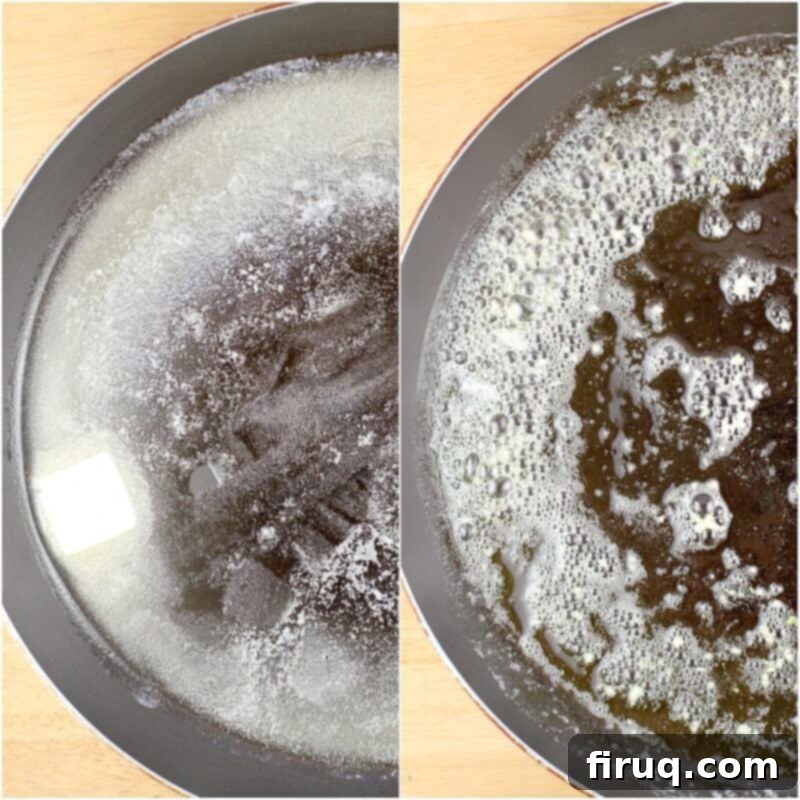
Avoid the “parmesan” found in unrefrigerated pantry aisles, specifically the kind in a green can often shelved near dried pasta. This product is typically heavily processed and contains cellulose to prevent caking, which means it will not melt smoothly into your sauce. Instead, it will result in a gritty, grainy texture and a lackluster flavor. While it might be passable for sprinkling on pizza, it is simply unsuitable for the delicate emulsification required for a truly creamy Alfredo.
Similarly, pre-bagged shredded Parmesan from the dairy section, though refrigerated, also often contains anti-caking agents that can hinder smooth melting. For a sauce as simple and ingredient-focused as Fettuccine Alfredo, every component’s quality is magnified. Investing in a good block of Parmigiano-Reggiano is a small effort that yields monumental flavor and texture rewards. Of course, always strive for the best quality ingredients you can reasonably access, understanding that circumstances and availability vary. Do what you can, and you’ll still be on your way to a fantastic meal.
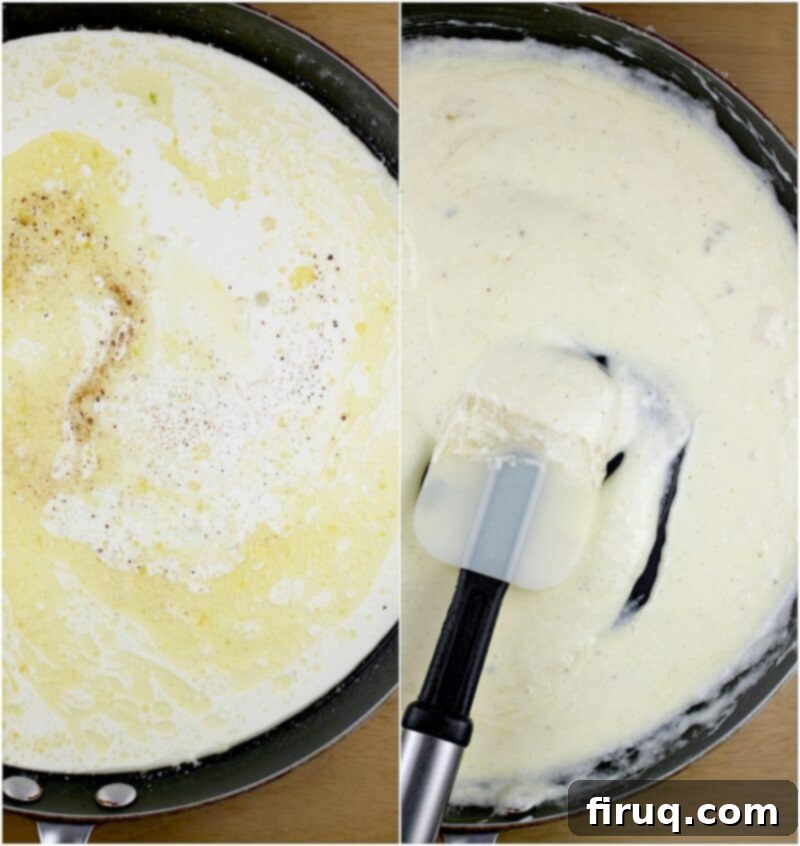
Simple Steps for a Perfect Alfredo
Despite its luxurious appeal, Fettuccine Alfredo is a remarkably quick dish to prepare. The beauty of this recipe lies in its efficiency: the sauce is almost entirely made while the pasta water comes to a boil and the fettuccine cooks. You can have this splendid meal ready in approximately 20 minutes, making it ideal for both weeknight dinners and special occasions.
First, begin by boiling a large pot of salted water for your pasta. As that heats up, melt the unsalted butter in a spacious skillet over medium heat. Once shimmering, add the minced garlic and sauté it gently for just a minute or two until it becomes wonderfully fragrant and turns a very light golden color. Be attentive during this stage, as garlic can burn quickly, which would impart a bitter flavor to your sauce.
Next, reduce the heat to low and carefully pour in the heavy cream. The cream will quickly incorporate with the melted butter, forming a smooth base. Stir in the crucial pinch of nutmeg at this point. This small addition is non-negotiable; nutmeg provides a subtle, warm depth that enhances the creaminess and complexity of the sauce without being overtly spicy. Allow the mixture to gently simmer, stirring occasionally, until it visibly thickens. This slow, low-heat simmering is key to preventing separation and achieving a smooth, consistent sauce.
While your sauce is thickening, cook the fettuccine pasta in the boiling water until it reaches the perfect al dente stage, following your package directions. This means the pasta should be firm to the bite but not hard. Before draining the pasta, remember to reserve about ½ cup of the starchy pasta water. This water is critical for achieving the ideal sauce consistency.
Once the pasta is cooked and drained (with the water reserved!), add the freshly grated Parmesan cheese and the reserved pasta water to your thickened cream sauce. Stir well to combine. The starchy pasta water will help emulsify the sauce, creating a glossy coating that will beautifully cling to every noodle. Season the sauce generously with kosher salt and fresh cracked pepper to taste, keeping in mind the cheese also contributes salinity.
Finally, add the hot, cooked fettuccine directly into the skillet with the sauce. Using tongs, toss the pasta vigorously until every strand is thoroughly coated in the luxurious Alfredo sauce. Serve immediately, as the sauce is best enjoyed fresh and hot.
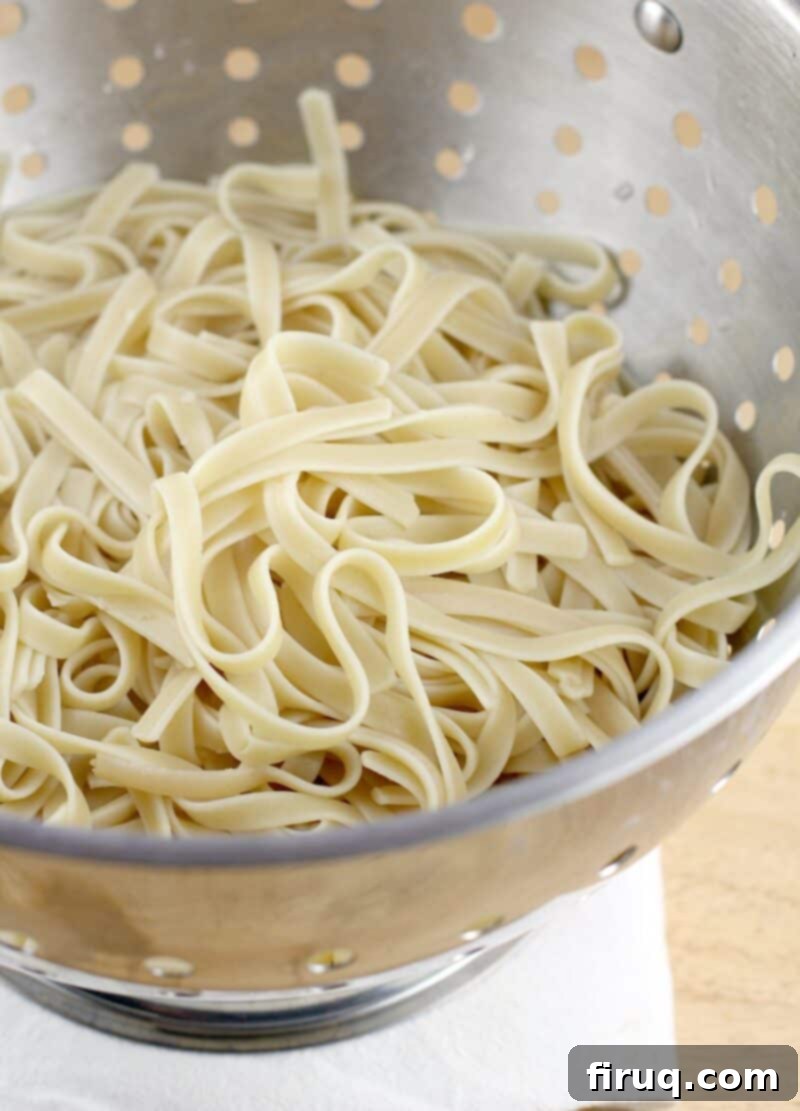
Can This Pasta Sauce Be Made in Advance?
One of the many blessings of Fettuccine Alfredo is its incredibly quick cooking time, making the overall preparation fast and straightforward. This means it’s often best enjoyed freshly made, right off the stove.
However, if you’re planning ahead for entertaining or simply want to minimize last-minute cooking, there is one strategic stopping point where you can prepare part of the sauce in advance. This allows you to be more “ready-to-go” when it’s time to serve.
After you’ve sautéed the garlic in the butter, and subsequently added the nutmeg and the cold heavy cream, you can halt the process. At this stage, before the sauce has fully thickened or the cheese has been added, remove the skillet from the heat, cover it tightly with foil or a lid, and set it aside. I have personally used this method when preparing for guests, allowing me to take care of this initial step hours before dinner.
When you’re ready to proceed with dinner, simply return the skillet to low heat. Gently warm the cream mixture, stirring until it comes back to a gentle simmer and begins to thicken. While it’s reheating, you can simultaneously cook your pasta. Once the sauce has thickened and the pasta is al dente, continue with adding the cheese, reserved pasta water, and tossing with the cooked pasta as per the recipe instructions. This approach streamlines your cooking process significantly without compromising the final quality of your fresh Alfredo.

The Shelf Life of Homemade Alfredo: Understanding Leftovers
While homemade Fettuccine Alfredo is an absolute delight when served fresh, it’s important to set realistic expectations for leftovers. The nature of a sauce primarily based on heavy cream and butter means it behaves differently than sauces with stabilizers or different fat compositions. When a cream- and butter-based sauce is allowed to cool completely and then reheated, or cooked for an extended period, the fats tend to separate from the liquid emulsion.
This separation is a natural occurrence, especially since we are crafting a truly homemade Alfredo, free from the artificial stabilizers (like soy lecithin) commonly found in commercially bottled sauces. While this lack of artificial additives is a positive sign of its authentic, quality ingredients, it does mean the sauce won’t hold up in the same way commercially prepared versions might.
The result of reheating separated Alfredo often leaves you with a pasta dish where the once-luscious sauce has broken down, leaving the noodles swimming in a pool of oily liquid. This texture is generally not appealing, significantly diminishing the culinary experience. Many people find themselves reluctantly consuming these leftovers, despite the separated fats.
Admittedly, I too am often guilty of eating my Alfredo leftovers, every single time, because it’s simply too delicious to waste! However, it’s crucial to be mentally prepared for the textural change. If you do find yourself with leftovers, try reheating them gently over very low heat on the stovetop, stirring constantly, and perhaps adding a splash of milk or extra cream to help re-emulsify the sauce. This can sometimes improve the texture, but it’s unlikely to fully restore the fresh-made perfection. For the absolute best experience, aim to enjoy your Fettuccine Alfredo immediately after preparation.
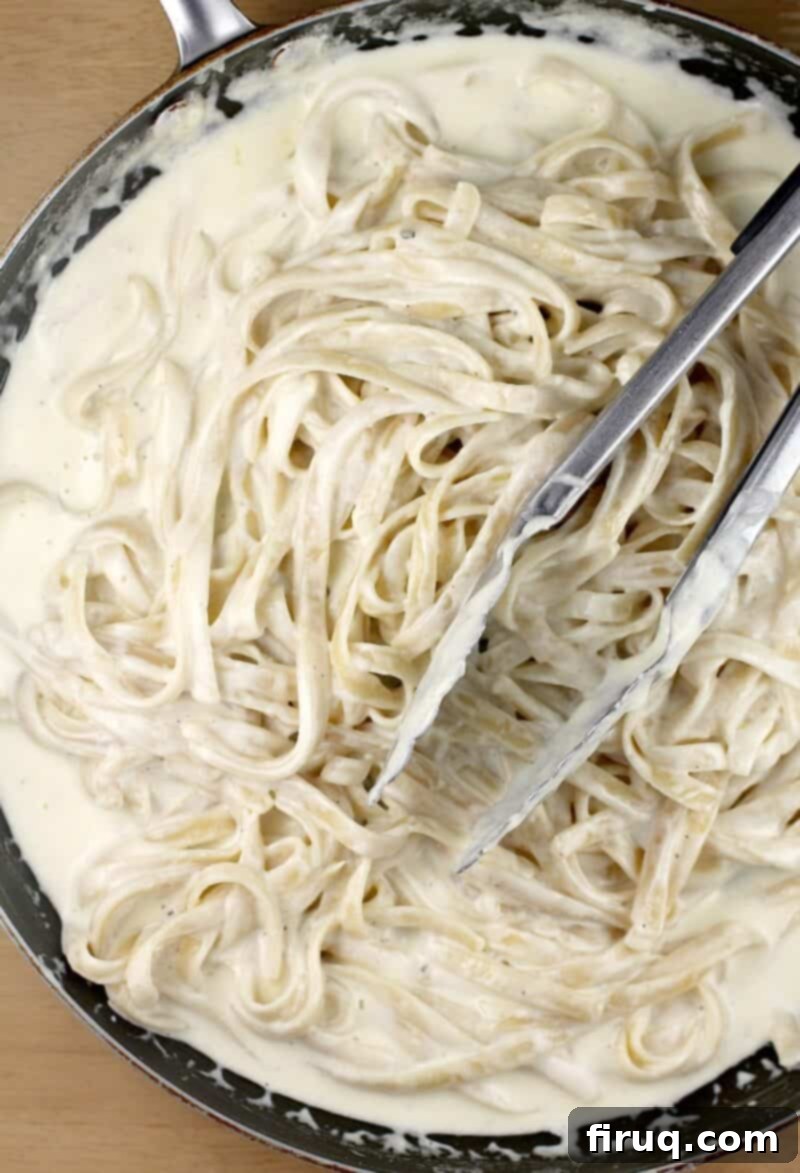
Elevate Your Alfredo: Creative Additions and Variations
While our classic Fettuccine Alfredo is undeniably a king among creamy pasta dishes, its versatility allows for wonderful customization. Adding a few extra ingredients can transform it into an even more substantial and personalized meal, catering to different tastes and cravings. Here are some customary, and a few not-so-customary, suggestions to enhance your homemade Fettuccine Alfredo:
- Chicken: A perennial favorite, cooked chicken pairs beautifully with Alfredo. Whether it’s leftover roasted chicken, pan-seared chicken breast, or shredded rotisserie chicken, this mild-tasting protein adds a hearty element without overpowering the sauce. Simply chop or shred and toss it in with the pasta.
- Shrimp: Seafood and creamy sauces are a match made in culinary heaven. Shrimp, in particular, is an excellent choice for Alfredo due to its quick cooking time and wide availability. Sauté shrimp separately with a little garlic and butter, then gently fold them into the finished pasta for an elegant and satisfying meal.
- Pulled Pork: This might sound like an unexpected pairing, but trust me, pulled pork is incredibly versatile. Its savory, tender nature can create a surprisingly delicious and comforting fusion with the creamy Alfredo. For inspiration, check out my Pulled Pork and Bacon Macaroni and Cheese recipe – the same principle of rich meat meeting a creamy sauce applies here.
- Spinach: For a delightful Florentine twist and a boost of greens, wilt fresh spinach into your Alfredo sauce. Add a generous handful of baby spinach leaves to the hot sauce just before tossing in the pasta. The residual heat will gently cook the spinach, adding a lovely color and a slightly earthy note.
- Mushrooms: Sautéed mushrooms add a wonderful depth of umami and a satisfying texture. Beautifully browned mushrooms, perhaps combined with some sweet peas and the sharp bite of green onions, make an incredible addition to Alfredo. Cook them separately until golden brown, then stir them into the sauce.
- Broccoli: Steamed or roasted broccoli florets provide a pleasant crunch and a touch of bitterness that balances the richness of the Alfredo sauce.
- Sun-Dried Tomatoes: For a burst of concentrated sweet and tangy flavor, thinly slice sun-dried tomatoes (oil-packed work best) and stir them into the sauce with the pasta.
Feel free to experiment with these additions or combine a few to create your signature Alfredo dish. The key is to add ingredients that complement the creamy base without overshadowing its classic appeal.
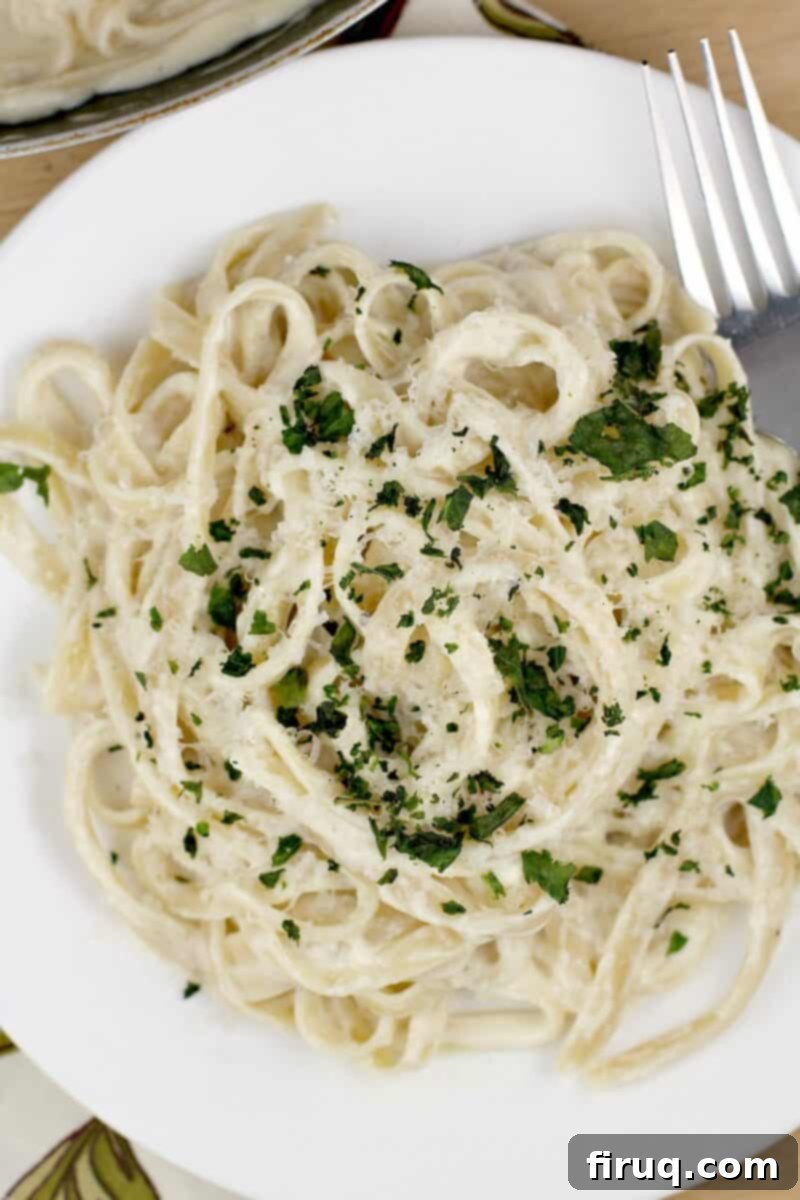
Perfect Pairings: Suggested Side Dishes for Fettuccine Alfredo
When indulging in a dish as rich and satisfying as Fettuccine Alfredo, the choice of side dishes can significantly enhance the overall dining experience. You might prefer to balance the decadence with light, fresh accompaniments, or perhaps you’re in the mood to go all-in with equally delicious sides, saving calorie concerns for another day. Whatever your preference, here are some suggestions, all of which beautifully complement the creamy goodness of Fettuccine Alfredo.
- Oven Roasted Broccoli in Dijon Pesto Vinaigrette: This vibrant and flavorful broccoli recipe is my personal favorite. The slight char from roasting combined with the tangy, herby vinaigrette offers a fantastic counterpoint to the richness of the Alfredo.
- Simple Roast Asparagus with Lemon: Perfectly roasted asparagus spears, brightened with a squeeze of fresh lemon, provide an elegant and fresh contrast. The subtle bitterness and crisp-tender texture are a welcome addition to the meal.
- Blackberry Balsamic Vinaigrette: A fresh green salad tossed with a sweet and tangy vinaigrette can cut through the richness of the pasta. The magic of sweet blackberries combined with the sharpness of balsamic vinegar creates a truly captivating dressing.
- Classic Caesar Salad: A timeless pairing, my Caesar salad recipe is traditional, featuring crisp romaine, garlicky croutons, and a creamy dressing. With the delightful (and optional!) addition of bacon, it offers a savory, tangy crunch that is simply irresistible alongside Alfredo.
Notice a common thread among these suggestions: a touch of acidity, whether from lemon or vinegar. This acidity acts as a perfect foil, cutting through the richness of the heavy cream and butter in the Alfredo sauce, cleansing the palate, and making each bite of pasta even more enjoyable. This balance is key to a well-rounded meal.
Beyond being a stellar main course, remember that Fettuccine Alfredo also excels as an incredibly special side dish. Imagine serving a smaller portion alongside a perfectly cooked filet mignon, a robust grilled NY strip steak, or some impeccably roasted chicken. It transforms any meal into an extra-special occasion, adding a touch of gourmet decadence to your plate.
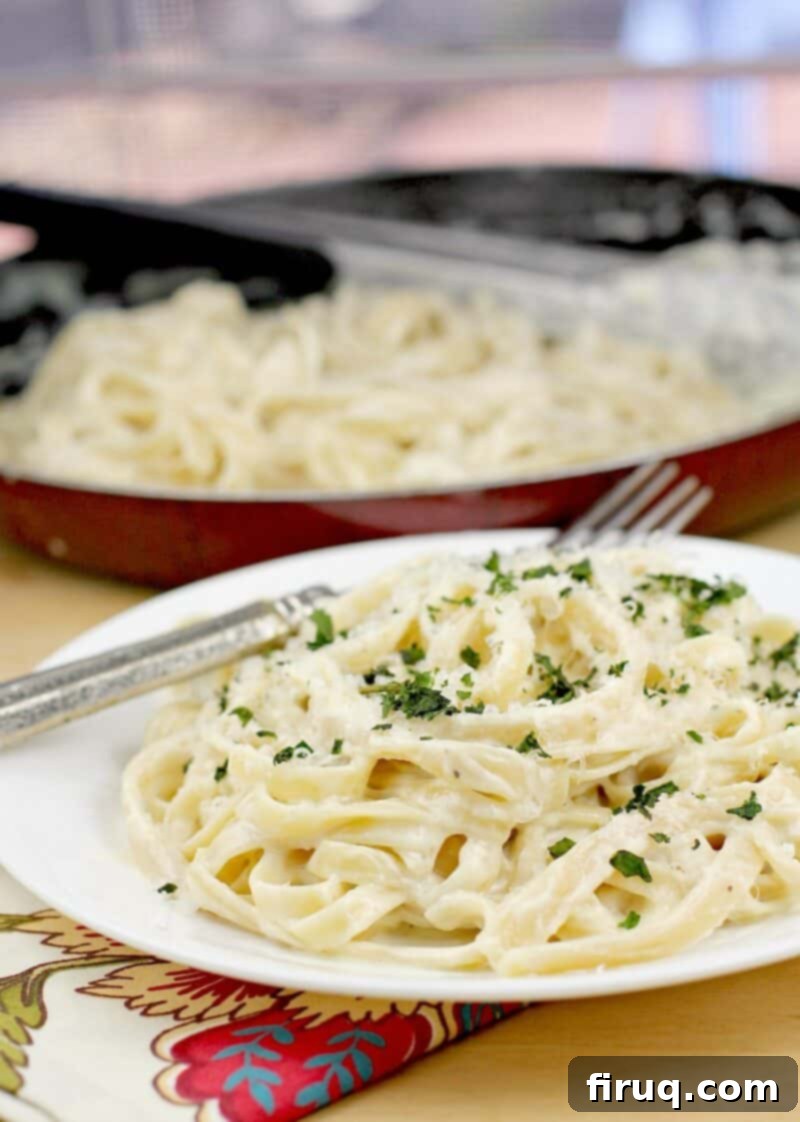
Last Essential Tips for Your Best Alfredo
To ensure your homemade Fettuccine Alfredo is nothing short of spectacular, keep these crucial tips in mind:
- Low Heat is Your Friend: Always allow the sauce to thicken gently over *low heat*. High heat will cause the cream to bubble aggressively, splatter, and potentially scorch, leading to a burnt taste and a broken sauce. Patience is key for a smooth, velvety consistency.
- Garlic in Moderation: It’s tempting to load up on garlic, especially if you’re a fan. However, for Alfredo, less is more. Stick to the recipe’s recommendation; too much garlic will overpower the delicate flavors of the cream and cheese, throwing the dish out of balance.
- Quality Cheese is Non-Negotiable: Make this extravagant sauce using only *real*, freshly grated Parmigiano-Reggiano cheese. Avoid pre-shredded or canned varieties, as they will compromise both the flavor and the smooth texture of your sauce, resulting in a grainy, unappetizing outcome.
- Don’t Forget the Pasta Water: This step is critical! Before you drain your cooked fettuccine, scoop out and reserve at least half a cup of the starchy pasta water. This magical liquid is essential for emulsifying the sauce, helping it to beautifully coat the pasta and achieve its signature creamy consistency.
- Cook Pasta Al Dente: When checking your pasta package, aim for the cook time specified for al dente. Noodles cooked to this stage will retain a slight bite. They will continue to cook and absorb the delicious Alfredo sauce once tossed together, ensuring they are perfectly tender and deeply flavored, rather than mushy.
FAQs
While a nonstick skillet is not strictly necessary for preparing Fettuccine Alfredo, it can significantly aid in the clean-up process. A well-seasoned cast iron or stainless steel skillet will also work, but you might need to stir more diligently to prevent sticking.
Absolutely! Many excellent gluten-free fettuccine options are available today. Just be sure to cook it according to the package directions until al dente and remember to reserve some of the starchy pasta water. The sauce itself is naturally gluten-free.
If you enjoy a touch of heat, you can add a pinch of red pepper flakes to the butter along with the garlic. Be mindful not to add too much, as you don’t want to overpower the delicate cream and cheese flavors.
Want to serve this special dinner with crusty bread and olive oil with seasonings like you would get in a restaurant? Check out my Italian Bread Dip Seasoning recipe.
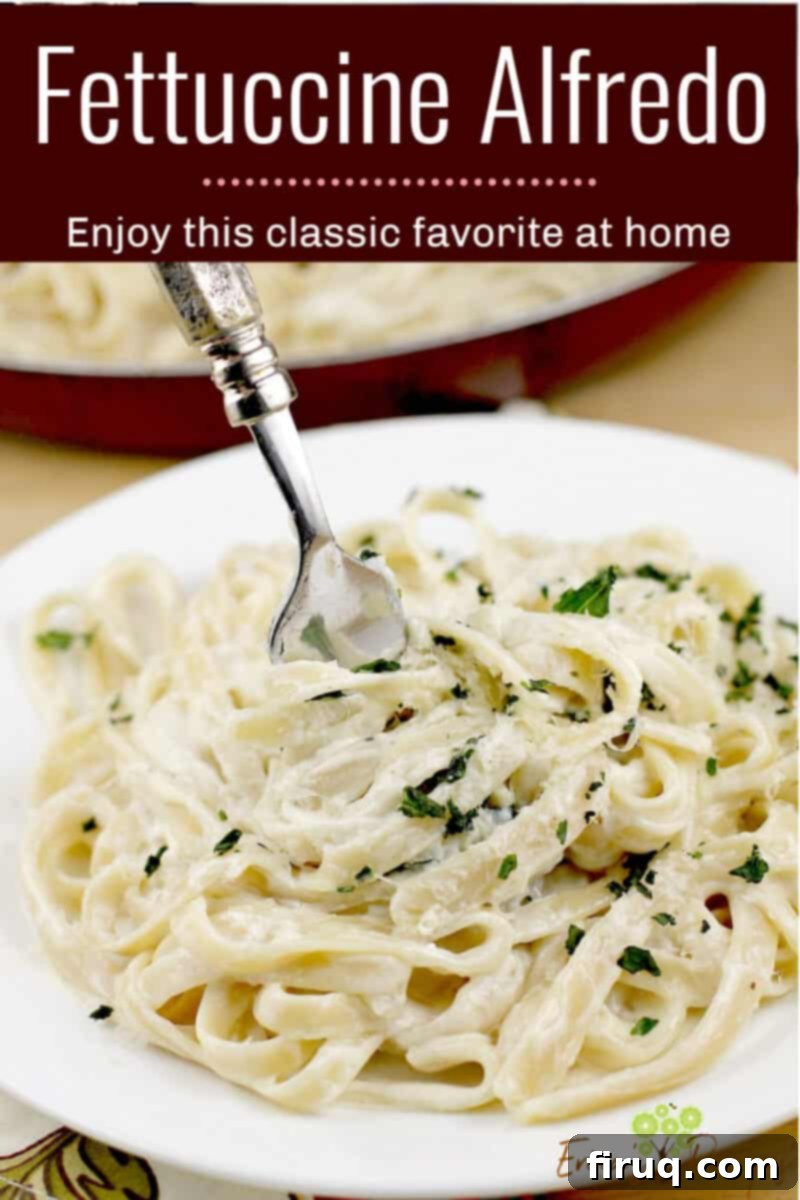
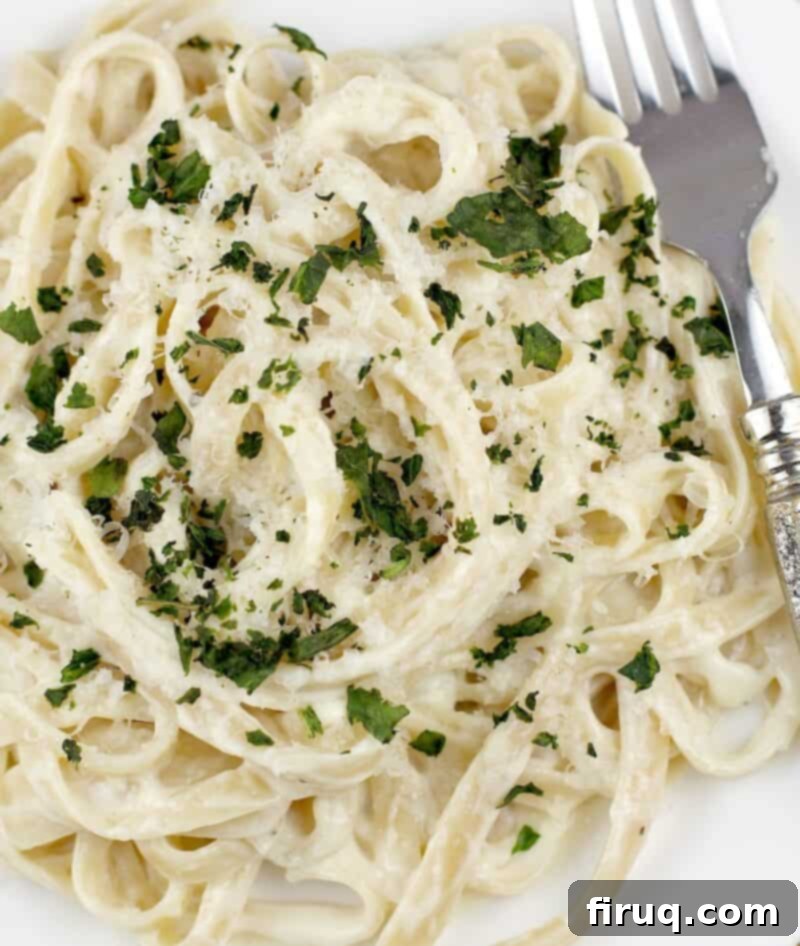
Fettuccine Alfredo
Print
Pin
Rate
Main Course
American, Italian
easy fettuccine alfredo, fettuccine alfredo, homemade fettuccine alfredo, creamy pasta
5 minutes
15 minutes
20 minutes
Erica
4
people
963
kcal
Ingredients
- 1 pint heavy cream
- 4 Tbsp unsalted butter
- ½ cup freshly grated Parmigiano-Reggiano cheese
- 1 small clove garlic finely minced or grated
- pinch freshly grated nutmeg
- ~½ tsp kosher salt to taste
- 1 pinch freshly cracked black pepper
- 1 lb fettuccine pasta
- reserved ½ cup starchy pasta water
- garnish: fresh herbs (such as Italian flat-leaf parsley or basil) and additional Parmesan
Instructions
-
Bring a large pot of salted water to a rolling boil for the pasta.
-
In a large skillet, melt the unsalted butter over medium heat. Add the minced garlic and sauté briefly, for about 1 minute, until it is fragrant and very lightly golden. Be careful not to burn it.
-
Pour in the heavy cream and add the pinch of nutmeg. Reduce the heat to low and simmer gently, stirring occasionally, until the sauce visibly thickens and coats the back of a spoon (about 5-7 minutes).
-
Meanwhile, cook the fettuccine pasta to al dente according to package directions. Before draining, reserve ½ cup of the starchy pasta water. Drain the pasta well.
-
Remove the sauce from heat. Add the freshly grated Parmesan cheese and the reserved ½ cup of pasta water to the sauce. Stir vigorously until the cheese is fully melted and the sauce is smooth and creamy. Season to taste with kosher salt and fresh cracked pepper.
-
Add the cooked pasta to the skillet with the sauce. Toss thoroughly with tongs until every strand of fettuccine is evenly coated. Garnish with fresh herbs and additional Parmesan if desired. Serve immediately for the best experience.
Notes
Detailed descriptions for ingredients, variations, make-ahead tips, and preparation nuances are provided in the main article above.
Nutrition
Calories:
963
kcal
